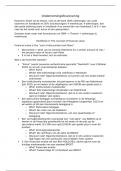Resume
Samenvatting Ondernemingsfinanciering HSH94A (16/20!)
- Établissement
- Katholieke Universiteit Leuven (KU Leuven)
Volledige Samenvatting schakeljaar handelswetenschappen KUL voor het vak Ondernemingsfinanciering van Bert D'espallier en zijn collega. Alsook voorbeeldoefeningen in de samenvatting! Ik behaalde een 16/20 doormiddel van enkel deze samenvatting te studeren.
[Montrer plus]



